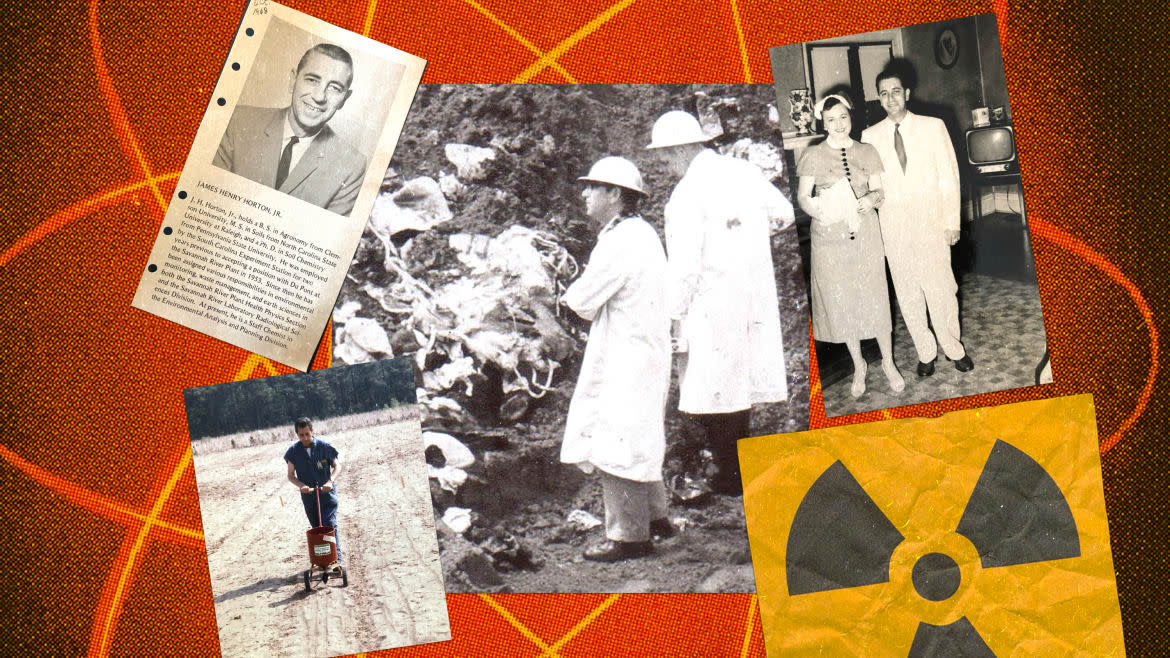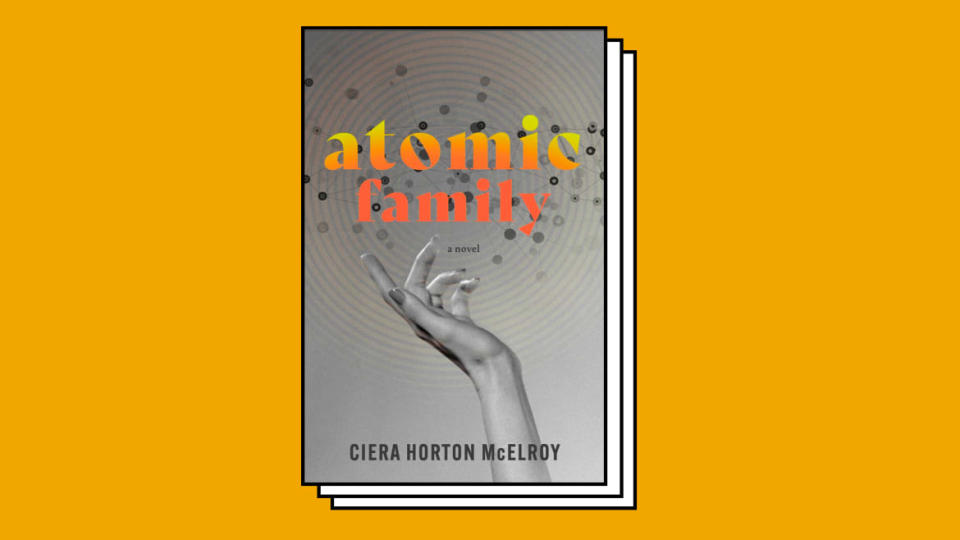Uncovering How My Grandfather Buried Nuclear Waste in South Carolina

- Oops!Something went wrong.Please try again later.
Do you know what we did with nuclear waste in the 1960s?
We buried it. In the ground. Literally.
Scientists with doctorates in soil science were commissioned to find the right place and just the right dirt to bury radioactive materials that would decay very, very, very slowly.
Growing up, I marveled at my dad’s stories of life in Cold War-era South Carolina. Duck and Cover drills felt utterly dystopian and Twilight Zone-ish to me. Combine that with my grandfather’s top-secret work as an agronomist—fancy word for soil scientist, A.K.A. nuclear waste disposer—at the Savannah River Plant, today one of the most dangerously contaminated places on the planet. It’s safe to say that the Southern Gothic setting for my novel Atomic Family was implanted in my imagination from early childhood.
The Savannah River Plant was a hydrogen bomb facility in Aiken, South Carolina. This was following the days of Robert Oppenheimer, after the race to create the first atomic bombs out west during the hush-hush of the Manhattan Project. World War II was over. We knew the destructive capabilities of atomic war. We even sent scientists to Hiroshima and Nagasaki to document the damage for themselves. (You made this thing, now see what you unleashed.) We had pictures and documentation of radiation sickness and, even, the risk of atmospheric testing.
When my grandfather was at work, an eerie delicacy had arisen with the Soviet Union. The hydrogen bomb had replaced the early atomic bomb. (Mere fireworks by comparison.) Even Robert Oppenheimer himself protested the hydrogen bomb. He famously argued—and would later lose his Atomic Energy Commission security clearance, and subsequently his entire professional reputation—that the mere atomic bomb was morally justifiable. But the hydrogen bomb? Well, that was a whole other story.
The Mystery of Chernobyl’s Black Frogs
And in some ways, I suppose it was.
My novel Atomic Family opens the day after the Soviets launched the largest hydrogen test bomb in history. They called it the Tsar Bomba. The bomb to end all bombs. It was, quite literally, the equivalent of 1,500 Hiroshimas, erupting in the Arctic. I cannot even wrap my mind around destruction like that.
And I like to imagine that my grandfather, Henry, could not either.
Henry Horton was, in my dad’s description and memory, a simple man. He was raised poor: the kind of poor that meant he was born in a one-bedroom rural cabin. His parents were farmers. He picked cotton in the summer and worked long hours outside of school. He was also wicked smart. But his road to a new life, like many other men his age, came strapped to military service. Henry joined the Clemson A&M ROTC, enlisting in the Navy shortly after Pearl Harbor. After the war he would return to Clemson, then earn a Ph.D. at Penn State. He worked in research until the Atomic Energy Commission offered him a role in the Health Physics lab at Savannah River.
Health Physics was a confusing department name, in my opinion, but it encompassed the study of the physical and environmental impact of radiation exposure and waste disposal. In other words, his job was to help assess how to contain and bury nuclear waste.

Why did they need a soil scientist and not, say, a physicist or biochemist? I had the same question. And that’s how I discovered the environmental angle of what would become my novel. To create a plot around the atomic facility, I used Henry’s actual declassified articles from the Health Physics department. He specifically studied the radioactive seepage of waste, how it moved through the dirt and reached groundwater or stream basins. Theoretically, Health Physicists would have had the power to halt any projects they deemed beyond the safety standard of contamination.
“Total containment of radioactive waste is the basic principle of guiding operations at the Savannah River Plant,” my grandfather wrote in 1961. “…The fuel fabrication area has released 0.8 curie of natural uranium to a stream since 1953.”
Uranium isotopes, I might add for those (like me) who are not scientifically minded, have a half-life of billions of years. That means that in billions of years, uranium will have only half of its current radiation levels. Let that sink in for a minute.
At the Savannah River Plant, some “low-level” waste was buried in the ground in unlined trenches, and “high-level” waste was contained in carbon-steel tanks.
But the methods weren’t watertight.
“A radioactive leak from the Savannah River nuclear weapons plant in South Carolina has caused lingering contamination of the Savannah River,” reported The New York Times in 1992, contamination that was ten times above the safety limit. “The leak contained tritium, a radioactive form of hydrogen, and forced a water utility downstream that serves 50,000 people in Jasper and Beaufort Counties in South Carolina, and two food companies in Savannah, Ga., to close their drinking water intake valves and shut off any flow from the river… Tritium can flow through the body and expose tissues to small amounts of radiation that can add to a person's risk of developing disease, including cancer.”
We’re talking about some serious stuff here.
But in 1953, when Henry accepted an offer from the plant, all of this was new. Radiation was a relatively novel field, so it’s not surprising that we had some issues along the way. Besides, I honestly doubt my grandfather really knew what his job would entail when he was hired. The AEC was cautious about giving out details before someone was under contract, as that could create a security risk. The hiring process itself was intense. There was an in-depth security background check and a physical exam and the necessity of secrecy. Henry could not tell his wife, Betty, what he did. He could not tell his one son, my dad.
Loose lips sink ships, warned the civil defense propaganda.
The Atomic Energy Commission found the location for the Savannah River Plant after in-depth environmental scouting. They needed somewhere spacious, somewhere private, somewhere with local water reservoirs for cooling purposes. They also needed the right soil composition. Ultimately, the government seized the land by eminent domain. (And, I may add, as this really warrants a whole other book, the land was populated by predominantly poor Black sharecroppers. This was, after all, the Jim Crow-era South.) Scientists like my grandfather began studying how they could trace and measure the contamination in the earth. How would rain and groundwater affect the spread of contamination? How would sandy topsoil compare to rich loamy clay?
This sounds very specific and granular. It is. And it’s also very important. There’s over 160 acres of hazardous waste in the Savannah River Plant burial ground. The kind of waste that will outlive all of us reading this article.
“That burial ground is where the plant dumped much of its solid radioactive waste at the time, often in cardboard boxes,” writes Doug Purdue in “Deadly Legacy,” an in-depth investigative article that I found invaluable when writing Atomic Family. “Radioactive contamination continues to leach from burial trenches into groundwater and periodically the Savannah River despite efforts to cap the trenches and stem the leakage. Plant engineers built a dam to block most of the flow and create a large pond. The contaminated pond water is used as irrigation and regularly sprayed into the surrounding forest where it is absorbed by the trees and evaporates harmlessly into the atmosphere. The pond also is home to two radioactive alligators dubbed by workers as Tritagator and Dioxinator — after two of the wastes, radioactive tritium and toxic dioxin. Solid radioactive waste continues to be dumped into unlined ditches and buried.” He wrote this in 2017.
There are irradiated alligators in the Savannah River. You just can’t make this stuff up.
Early in the days of writing the novel, there was a moment when I realized I needed to visit the Savannah River Plant for myself. Today the site is no longer active; instead, it’s dedicated to environmental clean-up. (Go figure.) Mostly, it is a relic of the Cold War days: prefab buildings and stark concrete laboratories full of archival materials and records.
The site now has tours open to the public, so my dad and I signed up for their historical guided tour.
The whole time we were there, I was nerding out. I was finally visiting the place I’d been studying. I saw the reactor towers and the nuclear graveyards, literal cemeteries for anything from exposed hazmat suits to irradiated paper and dosimeters. I saw the remains of the town that existed before atomic manufacturing took over. What stands out in my memory was a street-curb that survived the bulldozers, a remnant of another life.
I could imagine my characters here, what it would have been like. For my dad, it was different. He could imagine his father here.
“I finally get to go beyond the security checkpoint,” he told me. “For the first time.”
He has memories of being in the car as his mom dropped Henry off. There was barbed wire and a military checkpoint. And the deeply held belief that they were a target of the USSR. That atomic warfare hung in the balance: failure was not an option.
Sometimes I wonder what Henry would think if he knew, back in the ’60s, that the granddaughter he would never meet would one day write a novel about him. That I would go interview people he used to work with; walk past the security checkpoint; read the articles he published, the memos he sent that are now, fifty years later, de-classified. That I would try to make out the meaning behind redacted reports—redacted by whom, I always wonder? What didn’t they want us to know?
I think I will always wonder this.
Get the Daily Beast's biggest scoops and scandals delivered right to your inbox. Sign up now.
Stay informed and gain unlimited access to the Daily Beast's unmatched reporting. Subscribe now.

